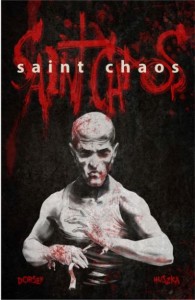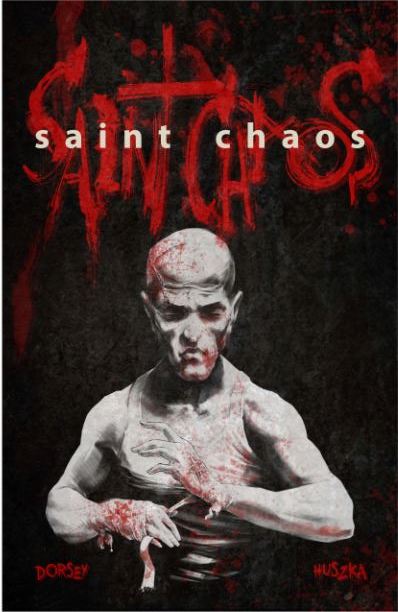
Saint Chaos
Noah Dorsey is one of the co-creators behind Image Comics’ Non-Humans, but now he’s taken to writing his own series, Saint Chaos. Saint Chaos tells the story of Simon Monroe, a man that’s just completely given up on life. His girlfriend cheated on him, he got kicked out of college, he lost his job, and his cat just committed suicide. To top it off, his mom was just killed in a botched robbery. Because of it all, Simon just wants to end it. But he can’t. No matter how badly he wants to, he can’t.
Simon almost gets his wish when a serial killer named Honeycomb kidnaps him at a local park, with the intention to torture and kill Simon. When Honeycomb discovers Simon’s desire to die, Honeycomb has a different plan. He releases Simon, telling him that he’ll die in four days. Honeycomb gives no details as to how, where, or when, just a four day lease on Simon’s life.
With his death set, Simon recklessly starts to help those that the city ignores. It’s while on his violent spree of justice that Saint Chaos is born. It’s while doling out justice as Saint Chaos that Simon finds a criminal who may know something about his mother’s death and Simon finds that he might be able to avenge that death. The only problem is that Simon dies in four days, and that’s something that Honeycomb doesn’t want to postpone.
As Saint Chaos nears its release on Comixology in May, Noah was kind enough to talk about the idea of a killer as an inadvertent force of good, the danger of candy making, and much more.
Leo Johnson: To start off, tell us a bit about yourself, if you would.
Noah Dorsey: Sure. I was born and bred in Denver. My father is a handmade candy maker and my mother does medical research. I actually grew up in the candy factory. A place called Hammond’s that we no longer own, but still exists somewhere in Denver. I would help out on the weekends making candy with my father since I was ten or eleven. A very family run operation. And if you’re thinking that it’s all Willy Wonka with chocolate waterfalls and gumdrop trees you’d definitely be wrong. Making handmade candy is extremely hard work. Dangerous even. The machines are not designed for safety. In fact, Honeycomb’s lair is a abandoned handmade candy factory and you’ll see that he uses some of these machines to torture his victims. It’s not that I ever thought that those machines could be used to torture someone, but my father had many stories of people horrifically hurting themselves accidentally. People have lost entire limbs making handmade candy. As I was writing Saint Chaos I thought it would be an interesting element to have this evil character work in a sweet place.

Saint Chaos
LJ: What was it that initially got you interested in comics?
ND: I was into comics at a young age, but I was that type that would just look at the cover. If it looked awesome I bought it. I didn’t respect the storytelling of comics like I do now. I just bought trades randomly and was rarely concerned with the story arc. I was all about the art and I gravitated toward the more darker stuff like I do now. Batman, Spawn, The Maxx, Shadowhawk – actually Shadowhawk I followed from beginning to end. That was probably the only series that I did. Later in life it was Sandman that convinced me that I could write comic books. I love that series. It’s embarrassing to admit but that’s also when I finally picked up Watchmen, Arkham Asylum and Dark Knight Returns. Those books are absolutely inspiring.
LJ: Where did the original idea for Saint Chaos come from?
ND: I wrote a screenplay back in 2006 with the same title and basic story line. I had optioned it to a small production company in LA back in 2007. They got a good director attached and set the budget at about one million. Evidently they got that money immediately so instead of going into production they raised the budget and started collecting more investors. This went on for about a year or so as I continued to turn in drafts of the script. In the beginning of 2008, at the height of the recession, all the investors pulled out and the producers dropped the option. After that I just threw it in a drawer and planned to do something later with it.
LJ: You’re a co-creator behind Image’s Non-Humans, but this is first time (as far as I know) that you’ve written a comic. What made you decide to step into writing with this story?
ND: Non-Humans is my first published comic. It was initially called Alter Egos and after the Saint Chaos movie fell apart the director and myself stayed in contact. We sat down one day and he asked if I had any other ideas on the burner. I told him about Alter Egos. He dug the idea and we pitched it to a production company that dug it as well. I got to writing a treatment, but Hollywood is a brutal, unapologetic place. I would turn in a draft and then have a meeting. After each meeting I would take notes and go make the changes they wanted. Ironically, the notes they would give me one meeting they would hate the next, and the blame would fall on me. I’m not looking for pity or hating on all those involved in the Hollywood, but this particular production company kept me running in circles. It was frustrating and we were going no where. Eventually we all just walked away. Later on Glen Brunswick got his hands on the material and wanted to make it into a comic book. The title got changed to Non Humans, Whilce Portacio was attached, and off we went. I am eternally grateful to Glen. Not only did he get Non Humans published, but he was a such a patient role model for my entrance into the comic industry. I had (and still have) many questions about the industry and he continues to answer them without annoyance.

Saint Chaos
LJ: In Saint Chaos, Simon, the protagonist, is completely down on his luck and has completely given up on life. What is it about this situation that makes him a good hero?
ND: This initial story arc is how Saint Chaos discovers his destiny. Every hero has his fall and then rise to his true calling, but it is usually revealed in a handful of brief moments so that the hero can get going on kicking some ass. With Saint Chaos I wanted to do the opposite. I wanted him to completely give up at the beginning. The first few pages of issue #1 he encounters Honeycomb with the expectation that he is going to die. Through the course of the first four issue story arc he discovers what all those great heroes do – they have a purpose. At first it is finding his mother’s killer and then it turns into something much bigger. Simon makes a great hero because he knows exactly what it means to face death. He has endured that very vulnerable place where life is meaningless. He knows what it is to be hopeless. The first story arc explores that. Once he has experienced one end of the spectrum can he climb to the other? I hate to be cliche, but the best way to explain it is the whole whatever doesn’t kill you makes you stronger adage. He is also human and susceptible to significant harm. He isn’t superhuman. He doesn’t have any special powers or fancy, expensive gadgets. He gets his ass handed to him in almost every fight he throws himself into. I mean, look at the cover to issue #1. He isn’t exactly in tip top condition. But he keeps getting up every time.
LJ: In a way, the killer Honeycomb is the cause for Simon’s heroics, as his death sentence hurried Simon into action. What was the thought process behind having a serial killer indirectly be a force of good?
ND: Great question. It is quite a basic good versus evil story. Honeycomb wants to kill Simon and Simon discovers that he doesn’t want













